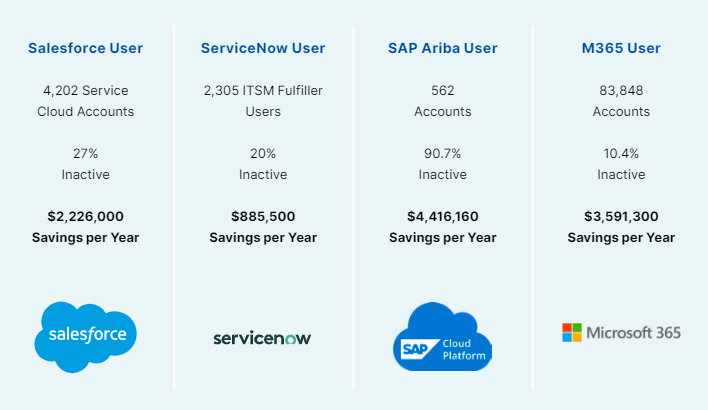In the last ten years, we've seen an explosion of SaaS applications and features hit the market. The current excitement about AI has only fueled this SaaS boom, as organizations rush to adopt the latest offerings from emerging vendors. The blog provides tips how you can avoid sprawl and streamline your SaaS costs effciently.
Market research shows that companies now use more than 300 SaaS apps on average, with spending reaching around $232 billion in 2024. Yet, it's astonishing that 53% of these SaaS licenses go unused—this is not just a minor oversight; it's a major drain on resources!
Key challenges in the SaaS and cloud space
IT teams and business units face two major challenges in the SaaS and cloud environments: mastering the complexity and achieving transparency in the IT stack and keeping rising costs under control. Navigating the vast array of SaaS applications can be overwhelming, with myriad options and costs to consider.
What used to be known as shadow IT has evolved into what's now called departmental or "democratized IT." The traditional role of IT departments as the gatekeepers of technology is diminishing as tech becomes essential to every aspect of business. For instance, the HR team might be more adept at choosing employee management software like SAP Success Factors than the IT department.
IT transparency deteriorates amid decentralization and sprawl
Prepare to seize control of your technology landscape. As various departments and individuals exercise autonomy in their technology decisions, the consequence often manifests as application sprawl. This proliferation of solutions, each essentially duplicating functionality, proves inefficient from a financial, productivity, and governance standpoint.
Let's acknowledge the imperative for streamlining. The multiplication of contracts introduces unnecessary complexity, the absence of standardization breeds disorder, and the unchecked adoption of applications poses elevated risks. Yet, a remedy is within reach.
IT teams and business units find themselves at the nexus of converging pressures, emanating from CTOs, CFOs, and other senior leaders, compelling them to enhance IT visibility and curtail costs amidst a backdrop of global challenges. Wrestling with a sense of loss of control and visibility, exacerbated by trends such as decentralization, they confront the impediment of unregulated SaaS expenditures hindering their cost management objectives.
Enter a compelling strategy: SaaS optimization through Software Asset Management. This approach furnishes the means to commandeer SaaS costs effectively and unlock considerable savings. The crux lies in concentrating efforts where they yield the greatest impact. Familiar with the 80/20 rule? It holds true, underscoring that a mere 20% of your software stack potentially engenders 80% of your savings. Notably, the top decile of SaaS applications within your organization is pivotal, accounting for roughly 30% of potential savings. Consequently, attention to the top 10 to 15 tools emerges as imperative, serving as potent levers to augment the bottom line.
Regain command over your SaaS budget utilizing a SAM tool
A Software Asset Management tool is indispensable for ensuring transparency and making the best possible use of the software budget. It enables you to effectively monitor and control your software investments and license obligations.
A SAM solution automatically determines which applications are in use and how many users are using them. This applies not only to applications in the company's own data center ("on premises"), but to software that a company obtains via a cloud as Software-as-a-Service (SaaS).

Graphic: Processes and standard use cases of USU Software Asset Management
For many years, USU’s enterprise customers with large IT infrastructures benefit from cost savings by 30% and more while mitigating technology risks. They achieve this because we follow a simple but effective path of SAM and SaaS optimization:
1. Identify and eliminate unused accounts
Kickstart your cost optimization journey by identifying and eliminating or reallocating unused SaaS accounts, unlocking immediate savings.
2. Optimize application usage and subscriptions
Analyze usage patterns to identify opportunities for downgrading subscriptions to more cost-effective options, ensuring that spending aligns with actual needs.
3. Automate provisioning and deprovisioning
Leverage automation to streamline the management of SaaS accounts, reducing operational costs and improving efficiency.
4. Reduce application sprawl
Consolidate applications to minimize redundancy and overlap, enhancing productivity, reducing risks, and cutting costs.
5. Proactively manage renewals
Adopt a proactive stance on SaaS renewals, using advanced insights to negotiate better terms, anticipate needs, and avoid last-minute decisions.
Savings in real numbers
The USU solution is not limited to determining the status quo. It also allows the reallocation and transfer of licenses to be initiated. This allows customers to adapt the type and number of licenses to actual requirements. Over-licensing and under-licensing are avoided.
This overview dives deep into our SAM engagements for SaaS optimization, laying out the real deal on total cost reduction opportunities that USU uncovered for large enterprise customers.

Conclusion
Attention, IT leaders, business leads, and all budget owners—take a proactive approach today to rein in the rising tide of SaaS spending tomorrow. Embrace actionable strategies and tools that empower you to take charge.
When you zero in on SaaS costs, you're not just making changes—you're reclaiming control over your SaaS expenditure and IT portfolio. This not only slashes the risks of shadow IT and software sprawl but also puts you firmly in the driver's seat.
Remember, trimming SaaS costs isn't a one-time fix; it's a journey of continuous improvement. Stay ahead of the game by regularly assessing your SaaS landscape, implementing savvy money-saving tactics, and fine-tuning your budget. By doing so, you'll ensure that your SaaS investment delivers maximum value at the best possible price.
Let us know if you have further questions, or if you’re interested in a meeting, where we can analyze your potential savings in a live demo. Learn more about USU Software Asset Management and schedule a free consultation.